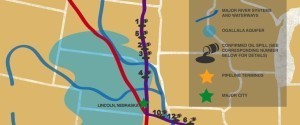TransCanada claims their pipelines are the safest in the continent. And the State Department seems inclined to agree having released their Final Environmental Impact Statement (EIS) on the Keystone XL pipeline last week. They find that the pipeline poses “no significant impacts” to the environment, and advise the project move forward.
So what about the 12 spills along the Keystone I line in its first year of operation? Since commencing operation in June of 2010, the Keystone I pipeline has suffered more spills than any other 1st year pipeline in U.S. history.
In addition to a nasty spill record, the proposed Keystone XL will cross one of the largest aquifers in the world – the Ogallala – which supplies drinking water to millions and provides 30% of the nation’s groundwater used for irrigation. Pipeline construction will also disrupt 20,782 acres, including 11,485 acres of native and modified grassland, rangeland and pastureland, and pipeline construction will threaten sensitive wildlife and aquatic species habitats.
According to the EPA, carbon emissions from tar sands crude are approximately 82% higher than the average crude refined in the U.S. Given the extremely toxic nature of tar sands bitumen and the fact that Keystone is TransCanada’s first wholly owned pipeline in the U.S., it seems reasonable to look to TransCanada’s performance with Keystone I for clues on how it would manage Keystone XL.
And the clues are telling.
For one, Keystone I is the youngest pipeline to have been considered an immediate threat to life, property and the environment by pipeline safety regulators.
This Keystone pipeline infographic below shows the spills documented in TransCanada’s publicly released safety records alongside the proposed route for Keystone XL, and indicates key risk areas near waterways and major metropolitan areas.
Check out the infographic below, and head over to the Huffington Post to read more.
Update: The graphic has been corrected to fix errors in #5 and #6. Thanks to the commenters who caught them.
Subscribe to our newsletter
Stay up to date with DeSmog news and alerts








